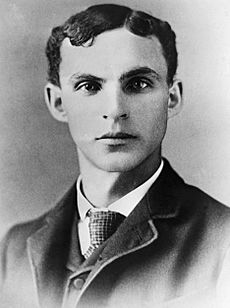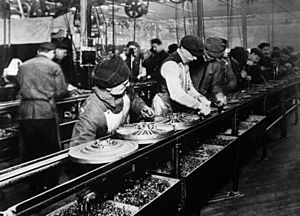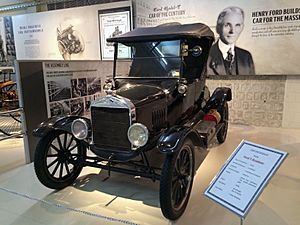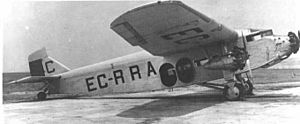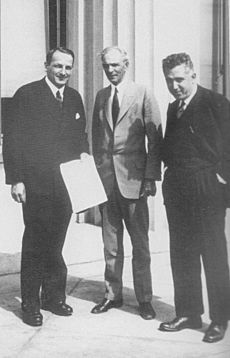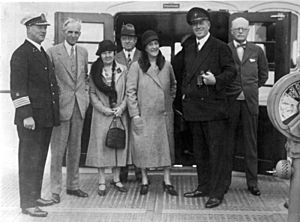Henry Ford facts for kids
Quick facts for kids
Henry Ford
|
|
|---|---|
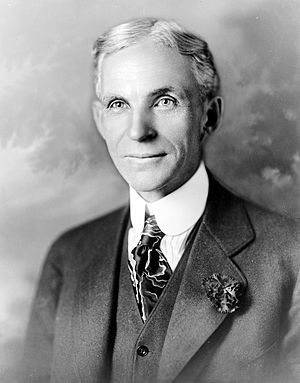
Photo by Fred Hartsook, c. 1919
|
|
| Born | July 30, 1863 |
| Died | April 7, 1947 (aged 83) Dearborn, Michigan, U.S.
|
| Resting place | St. Martha's Episcopal Church Cemetery, Detroit, Michigan, U.S. |
| Occupation | Engineer, industrialist, philanthropist |
| Years active | 1891–1945 |
| Known for | Founding and leading the Ford Motor Company Pioneering a system that launched the mass production and sale of affordable automotives to the public |
| Title | President of Ford Motor Company (1906–1919, 1943–1945) |
| Political party |
|
| Spouse(s) |
Clara Jane Bryant
(m. 1888) |
| Children | Edsel Ford |
| Signature | |
Henry Ford (July 30, 1863 – April 7, 1947) was an American engineer and businessman. He started making cars in 1896 and founded the Ford Motor Company.
He developed the idea of a system in which each worker has the duty to do one small part of the process of making something. His idea made it possible to produce cars in large numbers. This was called the assembly line.
Many factories around the world still make things this way. It was quite innovative at the time and it allowed him to produce many cars quickly and at a cheaper price than other car companies could.
As the Ford Motor Company sole owner, he became one of the richest and best-known people in the world. He is credited with "Fordism", the mass production of inexpensive goods coupled with high wages for workers. Ford was also among the pioneers of the five-day work week.
After his son Edsel died in 1943, Ford resumed control of the company but was too frail to make decisions and quickly came under the control of subordinates. He turned over the company to his grandson Henry Ford II in 1945. He died in 1947 after leaving most of his wealth to the Ford Foundation, and control of the company to his family.
Contents
Early life
Henry Ford was born July 30, 1863, on a farm in Springwells Township, Michigan. His father, William Ford (1826–1905), was born in County Cork, Ireland, to a family that had emigrated from Somerset, England in the 16th century. His mother, Mary Ford (née Litogot; 1839–1876), was born in Michigan as the youngest child of Belgian immigrants; her parents died when she was a child and she was adopted by neighbors, the O'Herns. Henry Ford's siblings were Margaret Ford (1867–1938); Jane Ford (c. 1868–1945); William Ford (1871–1917) and Robert Ford (1873–1934). Ford finished eighth grade at a one room school, Springwells Middle School. He never attended high school; he later took a bookkeeping course at a commercial school.
His father gave him a pocket watch when he was 12. At 15, Ford dismantled and reassembled the timepieces of friends and neighbors dozens of times, gaining the reputation of a watch repairman. At twenty, Ford walked four miles to their Episcopal church every Sunday.
Ford was devastated when his mother died in 1876. His father expected him to take over the family farm eventually, but he despised farm work. He later wrote, "I never had any particular love for the farm—it was the mother on the farm I loved."
In 1879, Ford left home to work as an apprentice machinist in Detroit, first with James F. Flower & Bros., and later with the Detroit Dry Dock Co. In 1882, he returned to Dearborn to work on the family farm, where he became adept at operating the Westinghouse portable steam engine. He was later hired by Westinghouse to service their steam engines.
Ford stated two significant events occurred in 1875 when he was 12. He received the watch, and he witnessed the operation of a Nichols and Shepard road engine, "...the first vehicle other than horse-drawn that I had ever seen". In his farm workshop, Ford built a "steam wagon or tractor" and a steam car, but thought "steam was not suitable for light vehicles," as "the boiler was dangerous." Ford also said that he "did not see the use of experimenting with electricity, due to the expense of trolley wires, and "no storage battery was in sight of a weight that was practical." In 1885, Ford repaired an Otto engine, and in 1887 he built a four-cycle model with a one-inch bore and a three-inch stroke. In 1890, Ford started work on a two-cylinder engine.
Ford stated, "In 1892, I completed my first motor car...". Ford added that "in the spring of 1893 the machine was running to my partial satisfaction and giving an opportunity further to test out the design and material on the road." Between 1895 and 1896, Ford drove that machine about 1000 miles. He then started a second car in 1896, eventually building three of them in his home workshop.
Marriage and family
Ford married Clara Jane Bryant (1866–1950) on April 11, 1888, and supported himself by farming and running a sawmill. They had one child, Edsel Ford (1893–1943).
Career
In 1891, Ford became an engineer with the Edison Illuminating Company of Detroit. After his promotion to Chief Engineer in 1893, he had enough time and money to devote attention to his experiments on gasoline engines. These experiments culminated in 1896 with the completion of a self-propelled vehicle, which he named the Ford Quadricycle. He test-drove it on June 4. After various test drives, Ford brainstormed ways to improve the Quadricycle.
Also in 1896, Ford attended a meeting of Edison executives, where he was introduced to Thomas Edison. Edison approved of Ford's automobile experimentation. Encouraged by Edison, Ford designed and built a second vehicle, completing it in 1898. Backed by the capital of Detroit lumber baron William H. Murphy, Ford resigned from the Edison Company and founded the Detroit Automobile Company on August 5, 1899. However, the automobiles produced were of a lower quality and higher price than Ford wanted. Ultimately, the company was not successful and was dissolved in January 1901.
With the help of C. Harold Wills, Ford designed, built, and successfully raced a 26-horsepower automobile in October 1901. With this success, Murphy and other stockholders in the Detroit Automobile Company formed the Henry Ford Company on November 30, 1901, with Ford as chief engineer. In 1902, Murphy brought in Henry M. Leland as a consultant; Ford, in response, left the company bearing his name. With Ford gone, Leland renamed the company the Cadillac Automobile Company.
Teaming up with former racing cyclist Tom Cooper, Ford also produced the 80+ horsepower racer "999," which Barney Oldfield was to drive to victory in a race in October 1902. Ford received the backing of an old acquaintance, Alexander Y. Malcomson, a Detroit-area coal dealer. They formed a partnership, "Ford & Malcomson, Ltd." to manufacture automobiles. Ford went to work designing an inexpensive automobile, and the duo leased a factory and contracted with a machine shop owned by John and Horace E. Dodge to supply over $160,000 in parts. Sales were slow, and a crisis arose when the Dodge brothers demanded payment for their first shipment.
Ford Motor Company
In response, Malcomson brought in another group of investors and convinced the Dodge Brothers to accept a portion of the new company. Ford & Malcomson was reincorporated as the Ford Motor Company on June 16, 1903, with $28,000 capital. The original investors included Ford and Malcomson, the Dodge brothers, Malcomson's uncle John S. Gray, Malcolmson's secretary James Couzens, and two of Malcomson's lawyers, John W. Anderson and Horace Rackham. Because of Ford's volatility, Gray was elected president of the company. Ford then demonstrated a newly designed car on the ice of Lake St. Clair, driving 1 mile (1.6 km) in 39.4 seconds and setting a new land speed record at 91.3 miles per hour (146.9 kilometres per hour). Convinced by this success, race driver Barney Oldfield, who named this new Ford model "999" in honor of the fastest locomotive of the day, took the car around the country, making the Ford brand known throughout the United States. Ford also was one of the early backers of the Indianapolis 500.
Model T
The Model T debuted on October 1, 1908. It had the steering wheel on the left, which every other company soon copied. The entire engine and transmission were enclosed; the four cylinders were cast in a solid block; the suspension used two semi-elliptic springs. The car was very simple to drive, and easy and cheap to repair. It was so cheap at $825 in 1908 ($26,870 today), with the price falling every year, that by the 1920s, a majority of American drivers had learned to drive on the Model T, despite the fact that drivers who were only familiar with the Model T's unique foot-operated planetary transmission and steering-column operated throttle-cum-accelerator had to learn a completely different set of skills to drive any other gasoline-powered automobile of the time.
Ford created a huge publicity machine in Detroit to ensure every newspaper carried stories and ads about the new product. Ford's network of local dealers made the car ubiquitous in almost every city in North America. As independent dealers, the franchises grew rich and publicized not just the Ford but also the concept of automobiling; local motor clubs sprang up to help new drivers and encourage them to explore the countryside. Ford was always eager to sell to farmers, who looked at the vehicle as a commercial device to help their business. Sales skyrocketed—several years posted 100% gains on the previous year. In 1913, Ford introduced moving assembly belts into his plants, which enabled an enormous increase in production. Although Ford is often credited with the idea, contemporary sources indicate that the concept and development came from employees Clarence Avery, Peter E. Martin, Charles E. Sorensen, and C. Harold Wills. (See Ford Piquette Avenue Plant)
Sales passed 250,000 in 1914. By 1916, as the price dropped to $360 for the basic touring car, sales reached 472,000.
By 1918, half of all cars in the United States were Model Ts. All new cars were black; as Ford wrote in his autobiography, "Any customer can have a car painted any color that he wants so long as it is black." Until the development of the assembly line, which mandated black because of its quicker drying time, Model Ts were available in other colors, including red. The design was fervently promoted and defended by Ford, and production continued as late as 1927; the final total production was 15,007,034. This record stood for the next 45 years, and was achieved in 19 years from the introduction of the first Model T (1908).
Henry Ford turned the presidency of Ford Motor Company over to his son Edsel Ford in December 1918. Henry retained final decision authority and sometimes reversed the decisions of his son. Ford started another company, Henry Ford and Son, and made a show of taking himself and his best employees to the new company; the goal was to scare the remaining holdout stockholders of the Ford Motor Company to sell their stakes to him before they lost most of their value. (He was determined to have full control over strategic decisions.) The ruse worked, and Ford and Edsel purchased all remaining stock from the other investors, thus giving the family sole ownership of the company.
In 1922, Ford also purchased Lincoln Motor Co., founded by Cadillac founder Henry Leland and his son Wilfred during World War I. The Lelands briefly stayed to manage the company, but were soon expelled from it. Despite this acquisition of a premium car maker, Henry displayed relatively little enthusiasm for luxury automobiles in contrast to Edsel, who actively sought to expand Ford into the upscale market. The original Lincoln Model L that the Lelands had introduced in 1920 was also kept in production, untouched for a decade until it became too outdated. It was replaced by the modernized Model K in 1931.
By the mid-1920s, General Motors was rapidly rising as the leading American automobile manufacturer. GM president Alfred Sloan established the company's "price ladder" whereby GM would offer an automobile for "every purse and purpose" in contrast to Ford's lack of interest in anything outside the low-end market. Although Henry Ford was against replacing the Model T, now 16 years old, Chevrolet was mounting a bold new challenge as GM's entry-level division in the company's price ladder. Ford also resisted the increasingly popular idea of payment plans for cars. With Model T sales starting to slide, Ford was forced to relent and approve work on a successor model, shutting down production for 18 months. During this time, Ford constructed a massive new assembly plant at River Rouge for the new Model A, which launched in 1927.
In addition to its price ladder, GM also quickly established itself at the forefront of automotive styling under Harley Earl's Arts & Color Department, another area of automobile design that Henry Ford did not entirely appreciate or understand. Ford would not have a true equivalent of the GM styling department for many years.
Model A and Ford's later career
By 1926, flagging sales of the Model T finally convinced Ford to make a new model. He pursued the project with a great deal of interest in the design of the engine, chassis, and other mechanical necessities, while leaving the body design to his son. Although Ford fancied himself an engineering genius, he had little formal training in mechanical engineering and could not even read a blueprint. A talented team of engineers performed most of the actual work of designing the Model A (and later the flathead V8) with Ford supervising them closely and giving them overall direction. Edsel also managed to prevail over his father's initial objections in the inclusion of a sliding-shift transmission.
The result was the successful Ford Model A, introduced in December 1927 and produced through 1931, with a total output of more than four million. Subsequently, the Ford company adopted an annual model change system similar to that recently pioneered by its competitor General Motors (and still in use by automakers today). Not until the 1930s did Ford overcome his objection to finance companies, and the Ford-owned Universal Credit Corporation became a major car-financing operation. Henry Ford still resisted many technological innovations such as hydraulic brakes and all-metal roofs, which Ford vehicles did not adopt until 1935–36. For 1932 however, Ford dropped a bombshell with the flathead Ford V8, the first low-price eight-cylinder engine. The flathead V8, variants of which were used in Ford vehicles for 20 years, was the result of a secret project launched in 1930 and Henry had initially considered a radical X-8 engine before agreeing to a conventional design. It gave Ford a reputation as a performance make well-suited for hot-rodding.
Ford did not believe in accountants; he amassed one of the world's largest fortunes without ever having his company audited under his administration. Without an accounting department, Ford had no way of knowing exactly how much money was being taken in and spent each month, and the company's bills and invoices were reportedly guessed at by weighing them on a scale. Not until 1956 would Ford be a publicly-traded company.
Also, at Edsel's insistence, Ford launched Mercury in 1939 as a mid-range make to challenge Dodge and Buick, although Henry also displayed relatively little enthusiasm for it.
Labor philosophy
Five-dollar wage

Ford was a pioneer of "welfare capitalism", designed to improve the lot of his workers and especially to reduce the heavy turnover that had many departments hiring 300 men per year to fill 100 slots. Efficiency meant hiring and keeping the best workers.
Ford astonished the world in 1914 by offering a $5 per day wage ($150 today), which more than doubled the rate of most of his workers. A Cleveland, Ohio, newspaper editorialized that the announcement "shot like a blinding rocket through the dark clouds of the present industrial depression". The move proved extremely profitable; instead of constant employee turnover, the best mechanics in Detroit flocked to Ford, bringing their human capital and expertise, raising productivity, and lowering training costs. Ford announced his $5-per-day program on January 5, 1914, raising the minimum daily pay from $2.34 to $5 for qualifying male workers.
Detroit was already a high-wage city, but competitors were forced to raise wages or lose their best workers. Ford's policy proved that paying employees more would enable them to afford the cars they were producing and thus boost the local economy. He viewed the increased wages as profit-sharing linked with rewarding those who were most productive and of good character. It may have been Couzens who convinced Ford to adopt the $5-day wage.
Real profit-sharing was offered to employees who had worked at the company for six months or more, and, importantly, conducted their lives in a manner of which Ford's "Social Department" approved. They frowned on heavy drinking, gambling, and on what are now called deadbeat dads. The Social Department used 50 investigators and support staff to maintain employee standards; a large percentage of workers were able to qualify for this "profit-sharing".
Ford's incursion into his employees' private lives was highly controversial, and he soon backed off from the most intrusive aspects. By the time he wrote his 1922 memoir, he had spoken of the Social Department and the private conditions for profit-sharing in the past tense. He admitted that "paternalism has no place in the industry. Welfare work that consists in prying into employees' private concerns is out of date. Men need counsel and men need help, often special help; and all this ought to be rendered for decency's sake. But the broad workable plan of investment and participation will do more to solidify the industry and strengthen the organization than will any social work on the outside. Without changing the principle we have changed the method of payment."
Five-day workweek
In addition to raising his workers' wages, Ford also introduced a new, reduced workweek in 1926. The decision was made in 1922, when Ford and Crowther described it as six 8-hour days, giving a 48-hour week, but in 1926 it was announced as five 8-hour days, giving a 40-hour week. The program apparently started with Saturday being designated a workday, before becoming a day off sometime later. On May 1, 1926, the Ford Motor Company's factory workers switched to a five-day, 40-hour workweek, with the company's office workers making the transition the following August.
Ford had decided to boost productivity, as workers were expected to put more effort into their work in exchange for more leisure time. Ford also believed decent leisure time was good for business, giving workers additional time to purchase and consume more goods. However, charitable concerns also played a role. Ford explained, "It is high time to rid ourselves of the notion that leisure for workmen is either 'lost time' or a class privilege."
Labor unions
Ford was adamantly against labor unions. He explained his views on unions in Chapter 18 of My Life and Work. He thought they were too heavily influenced by leaders who would end up doing more harm than good for workers despite their ostensible good motives. Most wanted to restrict productivity as a means to foster employment, but Ford saw this as self-defeating because, in his view, productivity was necessary for economic prosperity to exist.
He believed that productivity gains that obviated certain jobs would nevertheless stimulate the broader economy and grow new jobs elsewhere, whether within the same corporation or in others. Ford also believed that union leaders had a perverse incentive to foment perpetual socio-economic crises to maintain their power. Meanwhile, he believed that smart managers had an incentive to do right by their workers, because doing so would maximize their profits. However, Ford did acknowledge that many managers were basically too bad at managing to understand this fact. But Ford believed that eventually, if good managers such as he could fend off the attacks of misguided people from both left and right (i.e., both socialists and bad-manager reactionaries), the good managers would create a socio-economic system wherein neither bad management nor bad unions could find enough support to continue existing.
To forestall union activity, Ford promoted Harry Bennett, a former Navy boxer, to head the Service Department. Bennett employed various intimidation tactics to quash union organizing. On March 7, 1932, during the Great Depression, unemployed Detroit auto workers staged the Ford Hunger March to the Ford River Rouge Complex to present 14 demands to Henry Ford. The Dearborn police department and Ford security guards opened fire on workers leading to over sixty injuries and five deaths. On May 26, 1937, Bennett's security men beat members of the United Automobile Workers (UAW), including Walter Reuther, with clubs. While Bennett's men were beating the UAW representatives, the supervising police chief on the scene was Carl Brooks, an alumnus of Bennett's Service Department, and [Brooks] "did not give orders to intervene". The following day photographs of the injured UAW members appeared in newspapers, later becoming known as The Battle of the Overpass.
In the late 1930s and early 1940s, Edsel—who was president of the company—thought Ford had to come to a collective bargaining agreement with the unions because the violence, work disruptions, and bitter stalemates could not go on forever. But Ford, who still had the final veto in the company on a de facto basis even if not an official one, refused to cooperate. For several years, he kept Bennett in charge of talking to the unions trying to organize the Ford Motor Company. Sorensen's memoir makes clear that Ford's purpose in putting Bennett in charge was to make sure no agreements were ever reached.
The Ford Motor Company was the last Detroit automaker to recognize the UAW, despite pressure from the rest of the U.S. automotive industry and even the U.S. government. A sit-down strike by the UAW union in April 1941 closed the River Rouge Plant. Sorensen recounted that a distraught Henry Ford was very close to following through with a threat to break up the company rather than cooperate. Still, his wife Clara told him she would leave him if he destroyed the family business. In her view, it would not be worth the chaos it would create. Ford complied with his wife's ultimatum and even agreed with her in retrospect. Overnight, the Ford Motor Company went from the most stubborn holdout among automakers to the one with the most favorable UAW contract terms. The contract was signed in June 1941. About a year later, Ford told Walter Reuther, "It was one of the most sensible things Harry Bennett ever did when he got the UAW into this plant." Reuther inquired, "What do you mean?" Ford replied, "Well, you've been fighting General Motors and the Wall Street crowd. Now you're in here and we've given you a union shop and more than you got out of them. That puts you on our side, doesn't it? We can fight General Motors and Wall Street together, eh?"
Ford Airplane Company
Like other automobile companies, Ford entered the aviation business during World War I, building Liberty engines. After the war, it returned to auto manufacturing until 1925, when Ford acquired the Stout Metal Airplane Company.
Ford's most successful aircraft was the Ford 4AT Trimotor, often called the "Tin Goose" because of its corrugated metal construction. It used a new alloy called Alclad that combined the corrosion resistance of aluminum with the strength of duralumin. The plane was similar to Fokker's V.VII-3m, and some say that Ford's engineers surreptitiously measured the Fokker plane and then copied it. The Trimotor first flew on June 11, 1926, and was the first successful U.S. passenger airliner, accommodating about 12 passengers in a rather uncomfortable fashion. Several variants were also used by the U.S. Army. The Smithsonian Institution has honored Ford for changing the aviation industry. 199 Trimotors were built before it was discontinued in 1933, when the Ford Airplane Division shut down because of poor sales during the Great Depression.
World War I era
Ford opposed war, which he viewed as a terrible waste, and supported causes that opposed military intervention. Ford became highly critical of those who he felt financed war, and he tried to stop them. In 1915, the pacifist Rosika Schwimmer gained favor with Ford, who agreed to fund a Peace Ship to Europe, where World War I was raging. He led 170 other peace activists. Ford's Episcopalian pastor, Reverend Samuel S. Marquis, accompanied him on the mission. Marquis headed Ford's Sociology Department from 1913 to 1921. Ford talked to President Woodrow Wilson about the mission but had no government support. His group went to neutral Sweden and the Netherlands to meet with peace activists. A target of much ridicule, Ford left the ship as soon as it reached Sweden. In 1915, Ford blamed "German-Jewish bankers" for instigating the war.
According to biographer Steven Watts, Ford's status as a leading industrialist gave him a worldview that warfare was wasteful folly that retarded long-term economic growth. The losing side in the war typically suffered heavy damage. Small business were especially hurt, for it takes years to recuperate. He argued in many newspaper articles that a focus on business efficiency would discourage warfare because, “If every man who manufactures an article would make the very best he can in the very best way at the very lowest possible price the world would be kept out of war, for commercialists would not have to search for outside markets which the other fellow covets.” Ford admitted that munitions makers enjoyed wars, but he argued the most businesses wanted to avoid wars and instead work to manufacture and sell useful goods, hire workers, and generate steady long-term profits.
Ford's British factories produced Fordson tractors to increase the British food supply, as well as trucks and warplane engines. When the U.S. entered the war in 1917, Ford went quiet on foreign policy. His company became a major supplier of weapons, especially the Liberty engine for warplanes and anti-submarine boats.
In 1918, with the war on and the League of Nations a growing issue in global politics, President Woodrow Wilson, a Democrat, encouraged Ford to run for a Michigan seat in the U.S. Senate. Wilson believed that Ford could tip the scales in Congress in favor of Wilson's proposed League. "You are the only man in Michigan who can be elected and help bring about the peace you so desire," the president wrote Ford. Ford wrote back: "If they want to elect me let them do so, but I won't make a penny's investment." Ford did run, however, and came within 7,000 votes of winning, out of more than 400,000 cast statewide. He was defeated in a close election by the Republican candidate, Truman Newberry, a former United States Secretary of the Navy. Ford remained a staunch Wilsonian and supporter of the League. When Wilson made a major speaking tour in the summer of 1919 to promote the League, Ford helped fund the attendant publicity.
Willow Run
Before the U.S. entered the war, responding to President Roosevelt's call in December 1940 for the "Great Arsenal of Democracy", Ford directed the Ford Motor Company to construct a vast new purpose-built aircraft factory at Willow Run near Detroit, Michigan. Ford broke ground on Willow Run in the spring (April–June) of 1941, B-24 component production began in May 1942, and the first complete B-24 came off the line in October 1942. At 3,500,000 sq ft (330,000 m2), it was the largest assembly line in the world at the time. At its peak in 1944, the Willow Run plant produced 650 B-24s per month, and by 1945 Ford was completing each B-24 in eighteen hours, with one rolling off the assembly line every 58 minutes. Ford produced 9,000 B-24s at Willow Run, half of the 18,000 total B-24s produced during the war.
Edsel's death
When Edsel Ford died of cancer in 1943, aged only 49, Henry Ford nominally resumed control of the company, but a series of strokes in the late 1930s had left him increasingly debilitated, and his mental ability was fading. Ford was increasingly sidelined, and others made decisions in his name. The company was controlled by a handful of senior executives led by Charles Sorensen, an important engineer and production executive at Ford; and Harry Bennett, the chief of Ford's Service Unit, Ford's paramilitary force that spied on, and enforced discipline upon, Ford employees. Ford grew jealous of the publicity Sorensen received and forced Sorensen out in 1944. Ford's incompetence led to discussions in Washington about how to restore the company, whether by wartime government fiat, or by instigating a coup among executives and directors.
Forced out
Nothing happened until 1945 when, with bankruptcy a serious risk, Ford's wife Clara and Edsel's widow Eleanor confronted him and demanded he cede control of the company to his grandson Henry Ford II. They threatened to sell off their stock, which amounted to three quarters of the company's total shares, if he refused. Ford was reportedly infuriated, but had no choice but to give in. The young man took over and, as his first act of business, fired Harry Bennett.
International business
Ford's philosophy was one of economic independence for the United States. His River Rouge Plant became the world's largest industrial complex, pursuing vertical integration to such an extent that it could produce its own steel. Ford's goal was to produce a vehicle from scratch without reliance on foreign trade. He believed in the global expansion of his company. He believed that international trade and cooperation led to international peace, and he used the assembly line process and production of the Model T to demonstrate it.
He opened Ford assembly plants in Britain and Canada in 1911, and soon became the biggest automotive producer in those countries. In 1912, Ford cooperated with Giovanni Agnelli of Fiat to launch the first Italian automotive assembly plants. The first plants in Germany were built in the 1920s with the encouragement of Herbert Hoover and the Commerce Department, which agreed with Ford's theory that international trade was essential to world peace and reduced the chance of war. In the 1920s, Ford also opened plants in Australia, India, and France, and by 1929, he had successful dealerships on six continents. Ford experimented with a commercial rubber plantation in the Amazon jungle called Fordlândia; it was one of his few failures.
In 1929, Ford made an agreement with the Soviets to provide technical aid over nine years in building the first Soviet automobile plant (GAZ) near Nizhny Novgorod (Gorky) (an additional contract for construction of the plant was signed with The Austin Company on August 23, 1929). The contract involved the purchase of $30,000,000 worth of knocked-down Ford cars and trucks for assembly during the first four years of the plant's operation, after which the plant would gradually switch to Soviet-made components. Ford sent his engineers and technicians to the Soviet Union to help install the equipment and train the workforce, while over a hundred Soviet engineers and technicians were stationed at Ford's plants in Detroit and Dearborn "for the purpose of learning the methods and practice of manufacture and assembly in the Company's plants". Said Ford: "No matter where industry prospers, whether in India or China, or Russia, the more profit there will be for everyone, including us. All the world is bound to catch some good from it."
By 1932, Ford was manufacturing one-third of the world's automobiles. It set up numerous subsidiaries that sold or assembled the Ford cars and trucks:
- Ford of Australia
- Ford of Britain
- Ford of Argentina
- Ford of Brazil
- Ford of Canada
- Ford of Europe
- Ford India
- Ford South Africa
- Ford Mexico
- Ford Philippines
Ford's image transfixed Europeans, especially the Germans, arousing the "fear of some, the infatuation of others, and the fascination among all". Germans who discussed "Fordism" often believed that it represented something quintessentially American. They saw the size, tempo, standardization, and philosophy of production demonstrated at the Ford Works as a national service—an "American thing" that represented the culture of the United States. Both supporters and critics insisted that Fordism epitomized American capitalist development, and that the auto industry was the key to understanding economic and social relations in the United States. As one German explained, "Automobiles have so completely changed the American's mode of life that today one can hardly imagine being without a car. It is difficult to remember what life was like before Mr. Ford began preaching his doctrine of salvation". For many Germans, Ford embodied the essence of successful Americanism.
In My Life and Work, Ford predicted that if greed, racism, and short-sightedness could be overcome, then economic and technological development throughout the world would progress to the point that international trade would no longer be based on (what today would be called) colonial or neocolonial models and would truly benefit all peoples.
Racing
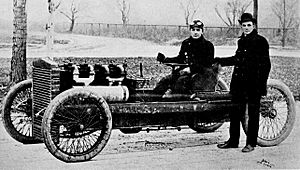
Ford maintained an interest in auto racing from 1901 to 1913 and began his involvement in the sport as both a constructor and a driver, later turning the wheel over to hired drivers. On October 10, 1901, he defeated Alexander Winton in a race car named "Sweepstakes"; it was through the wins of this car that Ford created the Henry Ford Company. Ford entered stripped-down Model Ts in races, finishing first (although later disqualified) in an "ocean-to-ocean" (across the United States) race in 1909, and setting a one-mile (1.6 km) oval speed record at Detroit Fairgrounds in 1911 with driver Frank Kulick. In 1913, he attempted to enter a reworked Model T in the Indianapolis 500 but was told rules required the addition of another 1,000 pounds (450 kg) to the car before it could qualify. Ford dropped out of the race and soon thereafter exited racing permanently, citing dissatisfaction with the sport's rules, demands on his time by the booming production of the Model T, and his low opinion of racing as a worthwhile activity.
In My Life and Work Ford speaks (briefly) of racing in a rather dismissive tone, as something that is not at all a good measure of automobiles in general. He describes himself as someone who raced only because in the 1890s through 1910s, one had to race because prevailing ignorance held that racing was the way to prove the worth of an automobile. Ford did not agree. But he was determined that as long as this was the definition of success (flawed though the definition was), then his cars would be the best that there were at racing. Throughout the book, he continually returns to ideals such as transportation, production efficiency, affordability, reliability, fuel efficiency, economic prosperity, and the automation of drudgery in farming and industry, but rarely mentions, and rather belittles, the idea of merely going fast from point A to point B.
Nevertheless, Ford did make quite an impact on auto racing during his racing years, and he was inducted into the Motorsports Hall of Fame of America in 1996.
Later career and death
When Edsel Ford, President of Ford Motor Company, died of cancer in May 1943, the elderly and ailing Henry Ford decided to assume the presidency. By this point, Ford, nearing 80 years old, had had several cardiovascular events (variously cited as heart attacks or strokes) and was mentally inconsistent, suspicious, and generally no longer fit for such immense responsibilities.
Most of the directors did not want to see him as president. But for the previous 20 years, though he had long been without any official executive title, he had always had de facto control over the company; the board and the management had never seriously defied him, and this time was no different. The directors elected him, and he served until the end of the war. During this period the company began to decline, losing more than $10 million a month ($169,120,000 today). The administration of President Franklin Roosevelt had been considering a government takeover of the company in order to ensure continued war production, but the idea never progressed.
His health failing, Ford ceded the company presidency to his grandson Henry Ford II in September 1945 and retired. He died on April 7, 1947, of a cerebral hemorrhage at Fair Lane, his estate in Dearborn, at the age of 83. A public viewing was held at Greenfield Village where up to 5,000 people per hour filed past the casket. Funeral services were held in Detroit's Cathedral Church of St. Paul and he was buried in the Ford Cemetery in Detroit.
Personal interests
A compendium of short biographies of famous Freemasons, published by a Freemason lodge, lists Ford as a member. The Grand Lodge of New York confirms that Ford was a Freemason, and was raised in Palestine Lodge No. 357, Detroit, in 1894. When he received the 33rd degree of the Scottish Rite in 1940, he said, "Masonry is the best balance wheel the United States has."
In 1923, Ford's pastor, and head of his sociology department, Episcopal minister Samuel S. Marquis, claimed that Ford believed, or "once believed," in reincarnation.
Ford published an anti-smoking book, circulated to youth in 1914, called The Case Against the Little White Slaver, which documented many dangers of cigarette smoking attested to by many researchers and luminaries. At the time, smoking was ubiquitous and not yet widely associated with health problems, making Ford's opposition to cigarettes unusual.
Interest in materials science and engineering
Henry Ford had a long-held interest in materials science and engineering. He enthusiastically described his company's adoption of vanadium steel alloys and subsequent metallurgic R&D work.
Ford also had a long-standing interest in plastics developed from agricultural products, particularly soybeans. He cultivated a relationship with George Washington Carver for this purpose. Soybean-based plastics were used in Ford automobiles throughout the 1930s in plastic parts such as car horns, in paint and other components. The project culminated in 1942, when Ford patented an automobile made almost entirely of plastic, attached to a tubular welded frame. It weighed 30% less than a steel car and was said to be able to withstand blows ten times greater than steel. It ran on grain alcohol (ethanol) instead of gasoline. The design never caught on.
Ford was interested in engineered woods ("Better wood can be made than is grown") (at this time plywood and particle board were little more than experimental ideas); corn as a fuel source, via both corn oil and ethanol; and the potential uses of cotton. Ford was instrumental in developing charcoal briquets, under the brand name "Kingsford". His brother-in-law, Edward G. Kingsford, used wood scraps from the Ford factory to make the briquets.
In 1927, Ford partnered with Thomas Edison and Harvey Samuel Firestone (each contributing $25,000) to create the Edison Botanic Research Corp. in Fort Myers, Florida to seek a native source of rubber.
Ford was a prolific inventor and was awarded 161 U.S. patents.
Florida and Georgia residences and community
Ford had a vacation residence in Fort Myers, Florida, next to that of Thomas Edison, which he bought in 1915 and used until approximately 1930. It still stands today as a museum.
He also had a vacation home (known today as the "Ford Plantation") in Richmond Hill, Georgia, which is now a private community. Ford started buying land in this area and eventually owned 70,000 acres (110 square miles) there. In 1936, Ford broke ground for a beautiful Greek revival style mansion on the banks of the Ogeechee River on the site of a 1730s plantation. The grand house, made of Savannah-gray brick, had marble steps, air conditioning, and an elevator. It sat on 55 acres (22 ha) of manicured lawns and flowering gardens. The house became the center of social gatherings with visitations by the Vanderbilts, Rockefellers, and the DuPonts. It remains the centerpiece of The Ford Plantation today. Ford converted the 1870s-era rice mill into his personal research laboratory and powerhouse and constructed a tunnel from there to the new home, providing it with steam. He contributed substantially to the community, building a chapel and schoolhouse and employing numerous local residents.
Preserving Americana
Ford had an interest in "Americana". In the 1920s, he began work to turn Sudbury, Massachusetts, into a themed historical village. He moved the schoolhouse supposedly referred to in the "Mary Had a Little Lamb" nursery rhyme from Sterling, Massachusetts, and purchased the historic Wayside Inn. The historical village plan never came to fruition. He repeated the concept of collecting historic structures with the creation of Greenfield Village in Dearborn, Michigan. It may have inspired the creation of Old Sturbridge Village as well. About the same time, he began collecting materials for his museum, which had a theme of practical technology. It was opened in 1929 as the Edison Institute. The museum has been greatly modernized and is still open today.
Henry Ford quotes
- “Whether you think you can or you think you can't, you’re right.”
- “It has been my observation that people get ahead during the time that others waste.”
- “You can’t build a reputation on what you’re going to do.”
- “There is no failure except failure to serve one’s purpose.”
- “When everything seems to be going against you, remember that the airplane takes off against the wind, not with it.”
- “You can’t learn in school what the world is going to do next year.”
- “Quality means doing it right when no one is looking.”
- “A business that makes nothing but money is a poor business.”
- “Obstacles are those frightful things you see when you take your eyes off your goal.”
Honors and recognition
- In December 1999, Ford was among 18 included in Gallup's List of Widely Admired People of the 20th Century, from a poll conducted of the American people.
- In 1928, Ford was awarded the Franklin Institute's Elliott Cresson Medal.
- In 1938, Ford was awarded Nazi Germany's Grand Cross of the German Eagle, a medal given to foreigners sympathetic to Nazism.
- The United States Postal Service honored Ford with a Prominent Americans series (1965–1978) 12¢ postage stamp.
- He was inducted into the Automotive Hall of Fame in 1946.
- In 1975, Ford was posthumously inducted into the Junior Achievement U.S. Business Hall of Fame.
- In 1985, he was inducted into the National Aviation Hall of Fame.
- He was inducted into the Motorsports Hall of Fame of America in 1996.
See also
 In Spanish: Henry Ford para niños
In Spanish: Henry Ford para niños
- Capitalist peace
- Detroit, Toledo and Ironton Railroad
- Dodge v. Ford Motor Company
- Edison and Ford Winter Estates
- Arthur Constantin Krebs
- Ferdinand Porsche
- Ferdinand Verbiest
- Ford family tree
- John Burroughs
- List of covers of Time magazine (1920s)
- List of richest Americans in history
- List of wealthiest historical figures
- Outline of Henry Ford
- Preston Tucker
- Ransom Olds
- William Benson Mayo


